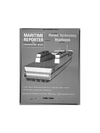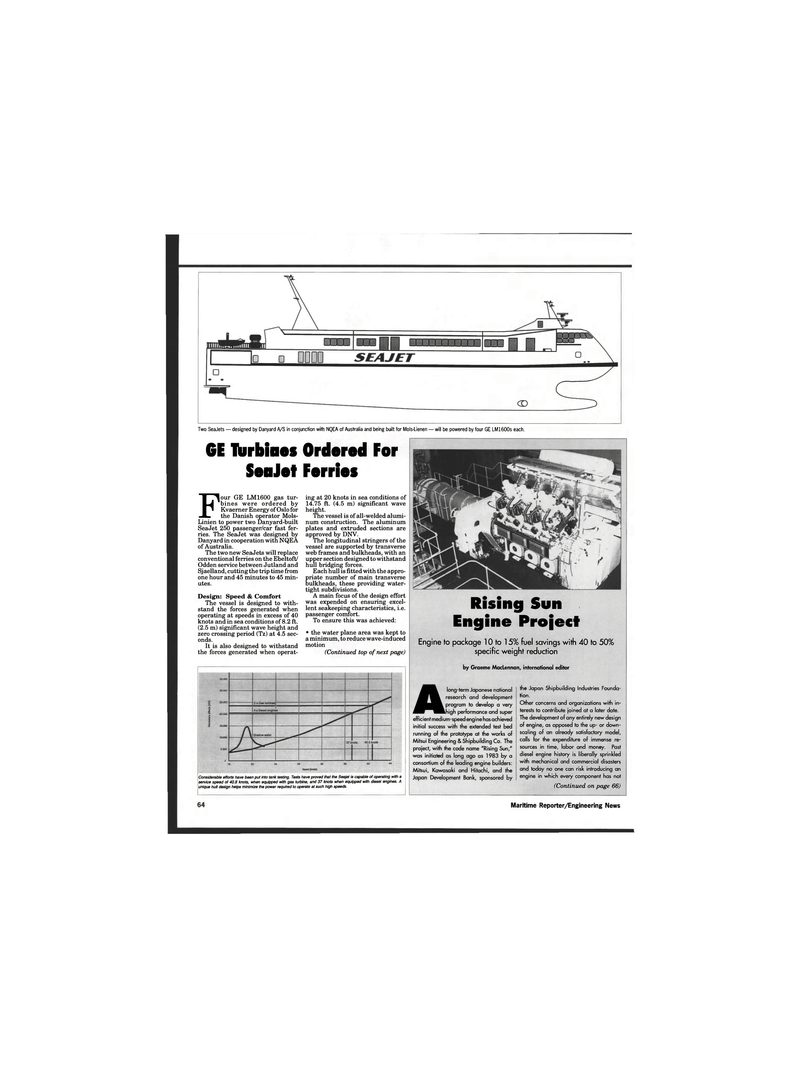
Page 54: of Maritime Reporter Magazine (April 1995)
Read this page in Pdf, Flash or Html5 edition of April 1995 Maritime Reporter Magazine
Two SeaJets — designed by Danyard IVS in conjunction with NQEA of Australia and being built for Mols-Lienen — will be powered by four GE LM1600s each.
GE Ikirbines Ordered For
SenJet Ferries by Graeme MacLennan, international editor
Four GE LM1600 gas tur-bines were ordered by Kvaerner Energy of Oslo for the Danish operator Mols-
Linien to power two Danyard-built
SeaJet 250 passenger/car fast fer- ries. The SeaJet was designed by
Danyard in cooperation with NQEA of Australia.
The two new SeaJets will replace conventional ferries on the Ebeltoft/
Odden service between Jutland and
Sjaelland, cutting the trip time from one hour and 45 minutes to 45 min- utes.
Design: Speed & Comfort
The vessel is designed to with- stand the forces generated when operating at speeds in excess of 40 knots and in sea conditions of 8.2 ft. (2.5 m) significant wave height and zero crossing period (Tz) at 4.5 sec- onds.
It is also designed to withstand the forces generated when operat- the Japan Shipbuilding Industries Founda- tion.
Other concerns and organizations with in- terests to contribute joined at a later date.
The development of any entirely new design of engine, as opposed to the up- or down- scaling of an already satisfactory model, calls for the expenditure of immense re- sources in time, labor and money. Past diesel engine history is liberally sprinkled with mechanical and commercial disasters and today no one can risk introducing an engine in which every component has not (Continued on page 66) ing at 20 knots in sea conditions of 14.75 ft. (4.5 m) significant wave height.
The vessel is of all-welded alumi- num construction. The aluminum plates and extruded sections are approved by DNV.
The longitudinal stringers of the vessel are supported by transverse web frames and bulkheads, with an upper section designed to withstand hull bridging forces.
Each hull is fitted with the appro- priate number of main transverse bulkheads, these providing water- tight subdivisions.
A main focus of the design effort was expended on ensuring excel- lent seakeeping characteristics, i.e. passenger comfort.
To ensure this was achieved: • the water plane area was kept to a minimum, to reduce wave-induced motion (Continued top of next page)
Rising Sun
Engine Project
Engine to package 10 to 15% fuel savings with 40 to 50% specific weight reduction
Considerable efforts have been put into tank testing. Tests have proved that the Seajet is capable of operating with a service speed of 40.8 knots, when equipped with gas turbine, and 37 knots when equipped with diesel engines. A unique hull design helps minimize the power required to operate at such high speeds.
Along-term Japanese national research and development program to develop a very high performance and super efficient medium-speed engine has achieved initial success with the extended test bed running of the prototype at the works of
Mitsui Engineering & Shipbuilding Co. The project, with the code name "Rising Sun," was initiated as long ago as 1983 by a consortium of the leading engine builders:
Mitsui, Kawasaki and Hitachi, and the
Japan Development Bank, sponsored by 56 Maritime Reporter/Engineering News

 53
53

 55
55
